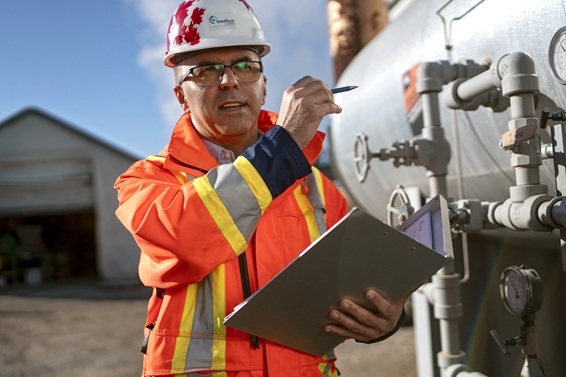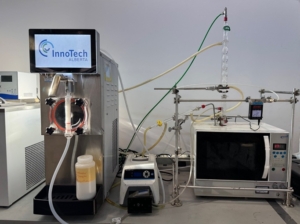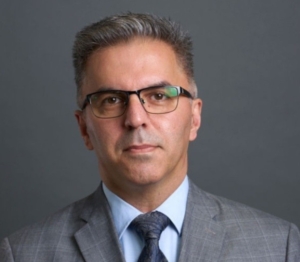
When global leaders in carbon capture and storage gather at the Edmonton Convention Centre September 23–25, InnoTech Alberta will showcase an innovation that could shift the economics of carbon management. At the heart of their exhibit is a novel phase-changing solvent and microwave regeneration system, a made-in-Alberta breakthrough designed to make carbon capture more efficient, sustainable, and affordable.
How the New System Works

At its core, this novel process called Phase-Changing Solvent and Microwave Regeneration (pictured left) converts a long-standing challenge in carbon capture into an opportunity. In traditional CO₂ capture systems, solvents like monoethanolamine absorb carbon dioxide from flue gas. The problem comes when regenerating the solvent: it requires large amounts of energy—up to 70 percent of a plant’s operating costs. Engineers designing these systems also want to prevent solids from forming, since they clog pumps and pipes. The team at InnoTech Alberta are taking the opposite approach. They deliberately push the solvent past its normal limits, cooling it until it forms a slush-like mix of solid and liquid. In most chemical engineering circles, this would be considered a design failure; but drawing on his years of experience in oil sands, where handling slurries is routine, team lead, Aref Najafi, saw it as a chance to reimagine the process.
Here’s how it works step by step:
- Absorption: A specialized solvent captures CO₂ from a gas stream. Instead of stopping while the solvent remains liquid , the process continues until the solvent becomes a thick slush, packed with CO₂.
- Slush Handling: Rather than using pumps, the slush is moved with equipment similar to that used in mining—large screws that steadily push material forward.
- Microwave Regeneration: The slush is fed into a proprietary microwave system. Because of the way microwaves interact only with polar molecules, the system efficiently breaks the bond between the CO₂ and the solvent.
- Recycling: The CO₂ is released and can be stored underground or converted into fuels, chemicals, and more. The solvent returns to the slush machine to repeat the cycle.
The team speculates that this approach should allow for a smaller system compared to the standard carbon capture towers (some 80 metres tall and 20 metres wide). By intensifying absorption and cutting energy demand by up to 70 percent, it has the potential to drive costs below $50 per tonne of CO₂—a step change in viability compared to today’s $80–100 per tonne.
Why Innovation Matters
“Our intent is to develop the next generation of CO₂ capture technology—sustainably and cost-effectively,” says Aref. “We want to make these technologies appealing to investors and entrepreneurs regardless of regulatory or political conditions. The biggest hurdle today is high capital and operational costs. This addresses both.”
The environmental benefits extend beyond efficiency. Because the process does not require substantial water inputs, it generates large amounts of condensate water from flue gas, which can be repurposed for industrial or agricultural use. The system is also fully electrified, reducing reliance on steam and potentially lowering the carbon footprint of the system itself.
The technology is already moving toward commercialization. A one-tonne-per-day microwave CO₂ capture unit, developed with Suncor, Cenovus, and federal and provincial governments, is slated to begin demonstration in 2026 at the Alberta Carbon Conversion Technology Centre (ACCTC). A similar pathway is being pursued for the phase-changing solvent.
Carbon Capture Canada
At this year’s Carbon Capture Canada event, InnoTech Alberta will showcase its phase-changing solvent and microwave regeneration system in an accessible way. Rather than complex lab setups, their display will feature just two pieces of familiar equipment—a slush machine and a microwave—demonstrating how a seemingly simple process can solve one of the most complex challenges in climate change.
“Conventional process engineers dislike solids in their liquids,” Aref notes. “But by merging phase-changing solvents with Alberta’s expertise in mineral processing and slurry handling, we’re well positioned to lead disruptive innovation in this field. This is creating new opportunities for out-of-the-box thinking and disruptive innovation, and we’re happy to be demonstrating this at the Carbon Capture Canada event.”
With the live demonstration, InnoTech isn’t just showing off a prototype, they’re delivering proof that innovation can lower energy use and cost in Carbon Capture, Utilization and Storage (CCUS) technologies.
InnoTech’s Role Derisking Technology
By turning what was once considered a “nightmare” in conventional engineering into an opportunity, InnoTech’s team is positioning Alberta as a hub for disruptive innovation in carbon capture. With delegates from more than eight countries expected to attend, including groups from Europe, the U.S., and Southeast Asia, the event offers a powerful stage to highlight Alberta’s leadership in advancing next-generation CCUS technologies.
What that mean for clients
Backed by deep expertise in scaling and commercialization, InnoTech’s services help clients turn lab-scale breakthroughs into deployable solutions through:
- Technology Development & Demonstration: InnoTech reduces the cost of CO₂ capture and develops carbon capture and conversion technologies. As part of the International Test Center Network, they support the global rollout of CCUS by scaling up innovations, improving performance, and lowering costs, with facilities like the Alberta Carbon Conversion Technology Centre providing a real-world proving ground.
- Industry Collaboration: Backed by $4.5 million in funding from Natural Resources Canada, Alberta Innovates, and industry partners, InnoTech makes CCUS more energy-efficient, cost-effective, and accessible.
- Expertise in Scaling Innovation: InnoTech’s approach bridges the gap between research and commercialization, ensuring that promising technologies reach real-world deployment.
- Accredited Greenhouse Gas validation and accreditation: InnoTech Alberta’s Standards Council of Canada accredited GHG validation and verification services provide the assurance industry needs to report emissions with confidence.
InnoTech makes carbon capture not just feasible but competitive. Learn more about how we can help you by visiting us online or coming to see us in person, Booth #109, Carbon Capture Canada conference.
The Innovation Journey

This breakthrough was borne not from success, but from what looked like failure. During earlier work, one solvent formulation began solidifying under cold conditions. For most engineers, this was the end of the line—a recipe for clogged pumps and blocked pipes.
But Najafi’s years in the oil sands told him otherwise. Mining operations deal with slurries every day. “If you stick to conventional thinking, the best you can hope for is incremental improvement,” he explains. “To make a step change, you have to think out of the box.”
By reframing the problem, his team transformed a “nightmare scenario” into the foundation of a new process. Today, what started as a flaw is being positioned as a global solution to one of the toughest challenges in climate change mitigation.